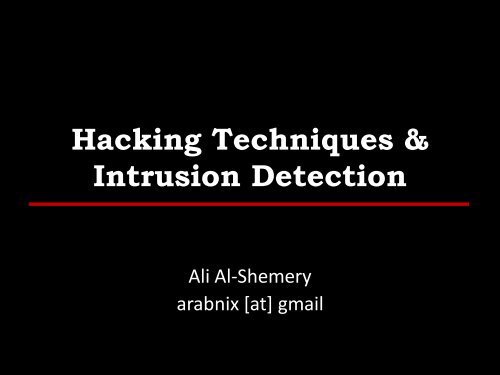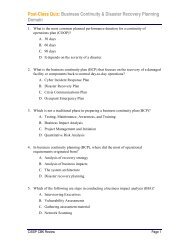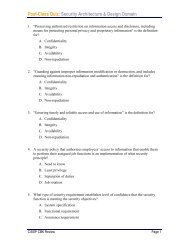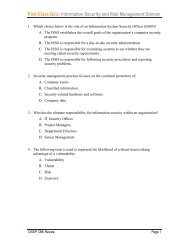Intrusion Detection
HTID_files/Day02-Physical Pentesting.pdf - OpenSecurityTraining.info
HTID_files/Day02-Physical Pentesting.pdf - OpenSecurityTraining.info
- No tags were found...
Create successful ePaper yourself
Turn your PDF publications into a flip-book with our unique Google optimized e-Paper software.
Hacking Techniques &<br />
<strong>Intrusion</strong> <strong>Detection</strong><br />
Ali Al-Shemery<br />
arabnix [at] gmail
All materials is licensed under a Creative Commons<br />
“Share Alike” license.<br />
• http://creativecommons.org/licenses/by-sa/3.0/<br />
2
# whoami<br />
• Ali Al-Shemery<br />
• Ph.D., MS.c., and BS.c., Jordan<br />
• More than 14 years of Technical Background (mainly<br />
Linux/Unix and Infosec)<br />
• Technical Instructor for more than 10 years (Infosec,<br />
and Linux Courses)<br />
• Hold more than 15 well known Technical Certificates<br />
• Infosec & Linux are my main Interests<br />
3
Physical Pentesting<br />
What good is your firewall or IDS/IPS if I can<br />
grab your box?
Outline – Physical Pentesting<br />
• Intro.<br />
• The Process<br />
• Techniques<br />
5
Overview<br />
• A Physical Penetration Test identifies<br />
the security weaknesses and<br />
strengths of the client's physical<br />
security.<br />
• The goal of the test is to demonstrate<br />
the existence or absence of<br />
deficiencies in operating procedures<br />
concerning physical security.<br />
6
Continue…<br />
Did You Know?<br />
• Physical Security is often overlooked in<br />
an organization<br />
• Physical Security breaches can have the<br />
same impact as computer breaches<br />
• Physical Security Attack & Penetration<br />
Tests should be conducted on high value<br />
facilities and locations annually<br />
• Physical Security Attack & Penetration<br />
Tests should be conducted by qualified<br />
personnel with years of experience<br />
7
The Process<br />
• Building an Operating Team<br />
• Project Planning<br />
• Rules of Engagement<br />
• Conducting Preliminary Research<br />
• Evaluating Risk<br />
• The Test Plan<br />
• Legal Issues and Documentation<br />
8
Building an Operating Team<br />
• Operator – all are operators<br />
• Team Leader – onsite/HQ<br />
• Coordinator or Planner – offsite/HQ<br />
• Social Engineer<br />
• Computer <strong>Intrusion</strong> Specialist<br />
• Physical Security Specialist<br />
• Surveillance Specialist<br />
9
Project Planning<br />
Plan your project, create a workflow to be sure that you cover all<br />
aspects of the assignment. A recommended approach (Wil Sopp):<br />
• Receiving the assignment – contracts signed and certain legal<br />
formalities observed.<br />
• Negotiating the Rules of Engagement – Define what you can and<br />
can’t do during testing and their purpose is usually to limit testers<br />
to a certain scope.<br />
• Performing Preliminary Research – Pursue the initial IG phase.<br />
– Determining Risk – Very important to accurately gauge the risk a<br />
project poses both to the company and to the team members<br />
executing it.<br />
– Writing a Test Plan – A formal (but flexible) test plan is a good<br />
idea from both project management and legal perspectives.<br />
– Gathering Equipment – Important for the team to take gear<br />
that’s appropriate to the test without being over encumbered.<br />
• Providing documentation and legal requirements – Once the<br />
planning stage is complete you will have a not insignificant amount<br />
of documentation.<br />
10
Rules of Engagement<br />
• Determine areas of security the client considers to be weak and<br />
wants tested.<br />
• Determine areas of testing the client wishes to avoid for legal<br />
reasons, such as close surveillance of staff.<br />
• Agree on team members that will carry out testing (Clearances might<br />
not be given to all).<br />
• Agree on test duration, or the maximum time permitted.<br />
• Agree about the information given in advance {white, grey, black}<br />
box testing.<br />
• Agree on the target assets (overall goals): something the team must<br />
acquire, identify, gain access to, or photograph. Examples include<br />
network operation centers, passwords or target personnel.<br />
• Agree on test success, failure, and abortion circumstances.<br />
• Agree on the actions to be taken directly following successful, failed<br />
and aborted tests.<br />
• Determine a schedule for presentation and post testing report.<br />
• After agreement is reached, document the RoE to be added to the<br />
project documentation.<br />
11
Conducting Preliminary<br />
Research<br />
• Human Intelligence (HUMINT).<br />
• Signals Intelligence (SIGINT).<br />
• Open Source Intelligence (OSINT).<br />
• Imagery Intelligence (IMINT).<br />
12
Evaluating Risk<br />
• Team leader’s responsibility to determine what constitutes an<br />
acceptable level of project risk. If level of risk is too high then<br />
the RoE should be reassessed or the test should not be<br />
carried out.<br />
RISK acronym – COLE:<br />
• Contractual Risks<br />
– Unable to complete assingment<br />
• Operational Risks<br />
– Inexperienced team members, technical communication failure<br />
• Legal Risks<br />
– Getting arrested<br />
• Environmental Risks<br />
– Presence of machinery or high voltage<br />
– Climbing and falling<br />
– Guard dogs<br />
– Extremes of heat or cold<br />
– Confronting armed security<br />
13
The Test Plan<br />
• Strategic:<br />
– High-level view of the project that details<br />
the goals, assets, team members,<br />
potential COLE risks, and necessary<br />
equipment.<br />
• Tactical:<br />
– List of milestones and the order of<br />
completion.<br />
• Operational:<br />
– Requirements to complete each milestone<br />
and how its completion will affect the<br />
whole engagement.<br />
14
Legal Issues and<br />
Documentation<br />
Includes but not limited to:<br />
• RoE<br />
• Test plan<br />
• Signed contracts<br />
• Copies of ‘get out of jail free’ cards<br />
• Scan of official ID of operating team<br />
members (passport, driving license)<br />
15
Techniques<br />
• Practical physical security testing<br />
• Site exploration<br />
• Tactical approaches<br />
– Tailgating to Gain Entry<br />
– Clothes Maketh the Man<br />
– Visiting a Nonexistent Employee<br />
• Badge security<br />
• Security mechanisms<br />
16
Physical Pentesting<br />
• Countermeasure<br />
• Mitigation<br />
• Remediation<br />
?<br />
17
SUMMARY<br />
• The importance of physical penetration<br />
testing, and why it must not be overseen,<br />
• Howto prepare for a physical pentesting,<br />
• Techniques used for physical pentesting,<br />
• Countermeasures, Mitigation, and<br />
Remediation for physical pentesting.<br />
18
References<br />
[-] Lock picking info., http://www.lockwiki.com/index.php/Main_Page<br />
[-] Lock picking tools, http://toool.us/<br />
[-] Learn Lock Picking, http://www.learnlockpicking.com<br />
[-] Video on Lock picking, http://video.google.com/videoplay?docid=-<br />
8536478434720082857&ei=8sKpSrG0J5jqqwK4tsytAw&q=lock+picking+phy<br />
sical+security&hl=en<br />
[-] Journal of Physical Security (JPS), http://jps.anl.gov/<br />
[-] Hardware Tools for Physical Pentesting,<br />
http://www.darkreading.com/vulnerabilitymanagement/167901026/security/vulnerabilities/231600749/tech-insightthree-hardware-tools-for-physical-penetration-testing.html<br />
19
















